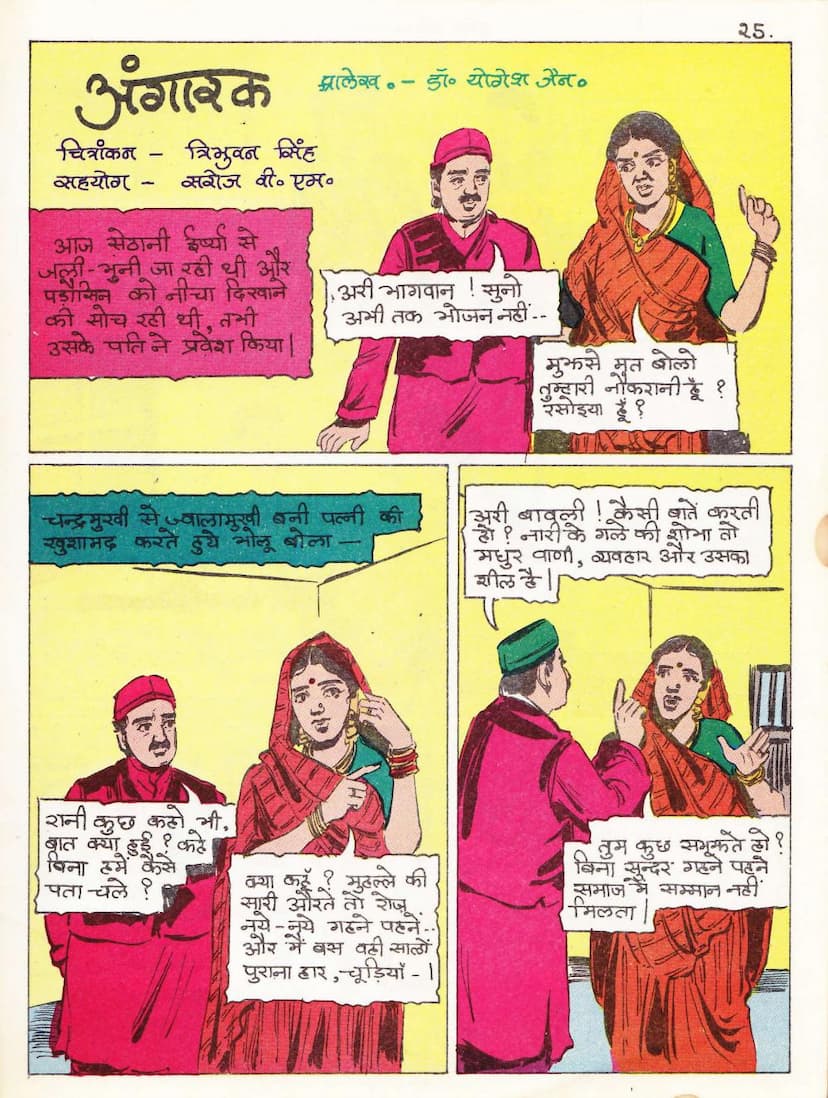Angarak
Added to library: September 1, 2025

Summary
Here's a comprehensive summary of the Jain comic book "Angarak" by Yogesh Jain, based on the provided pages:
Title: Angarak Author: Yogesh Jain Illustrator: Tribhuvan Singh Publisher: Mukti Comics
Overall Theme: The comic explores the Jain concepts of desire, attachment, karma, and the pursuit of spiritual liberation through the story of a skilled jeweler named Angarak. It highlights how worldly possessions and the pursuit of external validation can lead to suffering and moral compromise.
Summary of the Narrative:
The story begins with a discontented housewife, married to a jeweler named Bholuram. She is envious of her neighbor who flaunts new jewelry and feels inadequate with her old ornaments. Her husband tries to console her, emphasizing the importance of inner virtues over outward adornments. However, she insists that beautiful jewelry is necessary for social respect.
Desperate to please his wife, Bholuram visits a jeweler to find a unique and exquisite necklace. The jeweler introduces him to a legendary piece crafted by Angarak, a highly skilled jeweler to the king. However, he explains that Angarak no longer makes such jewelry, hinting at a significant event that changed his path.
Bholuram purchases the unique necklace, and his wife wears it to a festival, expecting admiration. To her dismay, no one notices her new jewelry, as they are preoccupied with their own possessions and envy. Disheartened, she devises a plan to draw attention to her ornaments by setting her house on fire. During the ensuing chaos, the neighbor, noticing the necklace and bangles, praises them. Bholuram scolds his wife for her foolishness, pointing out the futility of her actions when her house is burning. The wife then laments how her desire for jewelry led her to such desperate measures and asks about Angarak, the creator of these ornaments.
The narrative then shifts to Angarak's story. Angarak was a brilliant and intelligent jeweler to the king. One day, the king commissioned him to create jewelry unlike any seen before, providing him with gold and precious gems.
As Angarak prepares to work, he steps out of his home to wash his hands before his meal. He sees a Muni (ascetic) and considers it a great opportunity for spiritual merit (punya). He and his wife perform padagalan (honoring and offering food) to the Muni with navadha bhakti (nine-fold devotion).
After feeding the Muni, Angarak returns to his workspace, only to discover that the precious gem provided by the king is missing. He is distraught, fearing the king's wrath. He remembers placing it there and is desperate to find it. He suspects the Muni, whom he believes to be a thief, and in his anger and fear, he sets off into the forest to confront the Muni.
The Muni, a practitioner of the mahāvrata (great vows) of non-stealing (achaurya), remains silent and composed when Angarak arrives, spewing accusations and insults. Angarak, frustrated by the Muni's silence, threatens him. However, he notices the gem on a tree, lodged near a peacock. He realizes that the gem must have fallen there when the peacock, which often visited his courtyard, was present.
Angarak is filled with remorse for his false accusations and great offense against the Muni. He begs for forgiveness. Overcome with shame and self-condemnation, Angarak returns the gem to the king, admitting his mistake and stating that he wasted his precious human life chasing worldly attachments.
The king, however, encourages Angarak, suggesting that he is now ready to truly begin his work. Angarak agrees, declaring that he will now focus on crafting the "gem of self-control" within his pure soul, for which this rare human life is meant. The king blesses Angarak for his newfound wisdom.
Key Jain Concepts Illustrated:
- Desire and Attachment (Kama and Raga): The wife's envy and the pursuit of external validation through jewelry clearly demonstrate the destructive nature of desire and attachment.
- Karma: The story implies that Angarak's past karma might have led to the loss of the gem, and his reaction to it creates new karma. His eventual remorse and turn towards spiritual practice are seen as ways to mitigate negative karma.
- Spiritual Pursuit (Moksha Marga): The presence of the Muni and Angarak's act of devotion highlight the importance of spiritual path and the opportunity it presents for liberation.
- Devotion (Bhakti): Angarak and his wife's sincere offering to the Muni showcases the value of devotion in Jainism.
- Non-Stealing (Achaurya Mahavrata): The Muni's adherence to this vow is central to the story, contrasting with Angarak's false accusation.
- Self-Control (Sanyam): Angarak's realization and shift in focus from worldly gems to the "gem of self-control" represents the ultimate spiritual goal.
- Repentance and Forgiveness: Angarak's deep remorse and seeking forgiveness are crucial steps in his spiritual journey.
In essence, "Angarak" is a cautionary tale that emphasizes the emptiness of materialistic pursuits and the transformative power of spiritual wisdom and self-discipline within the Jain philosophy.